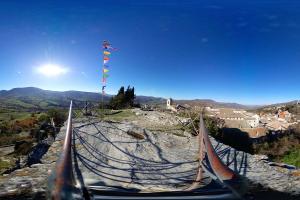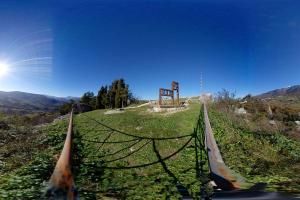Pennabilli
Primary tabs
Pennabilli
Pure poetry. A source of inspiration for one of the most creative and imaginative minds of our time. This medieval hamlet, on the western slopes of Monte Carpegna, was for twenty years the dwelling place of Tonino Guerra, who chose it as the location for his artistic activity.
So the "places of the soul" were born: unique paths in the world, which wind up along the streets of the mountain village and the Valmarecchia valley. Installations and initiatives that reinvent the relationship between art and urban spaces. This heritage, to be explored through the whole of Pennabilii, transforms the whole territory into one large museum.
It is impossible not to be charmed by the subtle magic of these original "museum areas", which blend man's fantasy with the wild nature of the landscape. Like the Garden of Forgotten Fruits, a museum of flavours that protects and enhances the spontaneous flora of the Apennines, preserving precious species such as the plumcot (a hybrid of a plum and an apricot), cornelian cherry, jujube, and Ciliego Cuccarina (a type of cherry). Dreamy atmospheres accompany the route through the Garden, dotted with fairy-tale works. Symbols, shapes and colours that, with simplicity, express universal messages: the “Snail Gate” and the “Uncontaminated Wood”, for example, invite reflection, slowness and the inner joy; the “Voice of the Leaf” fountain symbolises the lymph of life, through its jets of water.
From the Garden of Forgotten Fruits, continuing along the streets of the village, one can follow the wonderful Strada delle Meridiane (Route of the Sundials), along which one can see beautiful sundials, that mark the time with different methods from various epochs. Along this charming road, there is an original tribute to Federico Fellini and Juliet Masina, whose faces meet in a poetic game of shadows.
If the "places of the soul" evoke a profound spirituality, so do the historic sites of the village, testimonies to a past intimately linked to religious worship. The ancient presence of the diocese has left a valuable ecclesiastical architectural heritage, such as the Cathedral, the Shrine of Sant'Agostino, the monument of the Madonna delle Grazie, the Augustinian Convent as well as the Church and the Hospital of the Misericordia.
The very name of the town is linked to the religious world, whose foundation dates back to Etruscan-Roman times: if "Penna" refers to the summit on which it rises, "Billi" should come from the word “Bel”, the Etruscan name of God Bal. For the centuries the municipality was divided into the two castles of Pen and Billi, the area became a single municipality in 1350: to seal the pact, the "stone of peace” was laid, today placed near the fountain in the main square of the town







